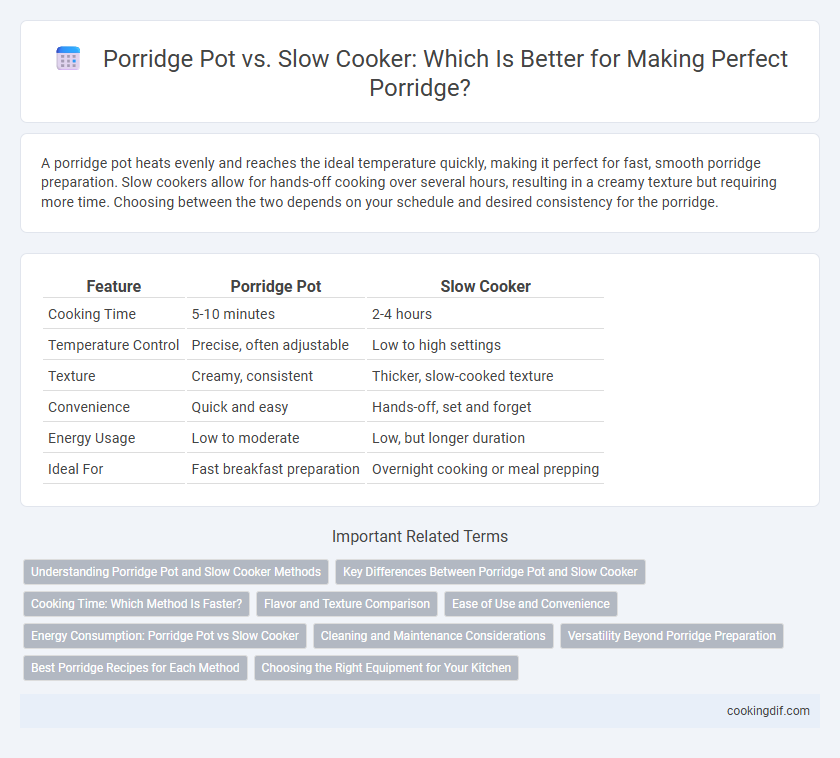A porridge pot heats evenly and reaches the ideal temperature quickly, making it perfect for fast, smooth porridge preparation. Slow cookers allow for hands-off cooking over several hours, resulting in a creamy texture but requiring more time. Choosing between the two depends on your schedule and desired consistency for the porridge.
Table of Comparison
| Feature | Porridge Pot | Slow Cooker |
|---|---|---|
| Cooking Time | 5-10 minutes | 2-4 hours |
| Temperature Control | Precise, often adjustable | Low to high settings |
| Texture | Creamy, consistent | Thicker, slow-cooked texture |
| Convenience | Quick and easy | Hands-off, set and forget |
| Energy Usage | Low to moderate | Low, but longer duration |
| Ideal For | Fast breakfast preparation | Overnight cooking or meal prepping |
Understanding Porridge Pot and Slow Cooker Methods
Porridge pots are specifically designed for cooking porridge with controlled heat distribution and often feature non-stick surfaces to prevent sticking, ensuring smooth texture. Slow cookers offer a set-it-and-forget-it approach, using low and steady heat over several hours, which allows oats to absorb liquid thoroughly and develop creamy consistency. Understanding the differences in heat application and cooking time between a porridge pot and slow cooker helps achieve desired porridge texture efficiently.
Key Differences Between Porridge Pot and Slow Cooker
A porridge pot is specifically designed for cooking porridge with rapid heat distribution and precise temperature control, ideal for quick preparation and consistent texture. In contrast, a slow cooker operates at lower temperatures over an extended period, offering hands-off convenience and enhanced flavor development but requiring longer cooking times. The key differences lie in cooking speed, temperature range, and user control, with porridge pots suited for immediate breakfast needs and slow cookers for overnight or all-day meal preparation.
Cooking Time: Which Method Is Faster?
Porridge cooked in a traditional pot on the stovetop typically takes around 5 to 10 minutes, offering a faster option compared to a slow cooker, which requires 2 to 4 hours depending on the settings. The stovetop method heats quickly and allows immediate control over the cooking process, resulting in quicker preparation. Slow cookers excel in unattended cooking but are significantly slower in producing ready-to-eat porridge.
Flavor and Texture Comparison
A porridge pot typically achieves a creamier texture by maintaining steady, moderate heat that prevents scorching and allows grains to release starch evenly. Slow cookers, while convenient for unattended cooking, can produce a softer, sometimes mushier consistency due to longer cooking times and lower, less precise temperature control. Flavor intensity in porridge pots is often more pronounced as gradual evaporation concentrates taste, whereas slow cookers may dilute flavors slightly due to retained moisture in the sealed environment.
Ease of Use and Convenience
A porridge pot offers precise temperature control and faster cooking times, making it ideal for quick, consistent meals. Slow cookers require less attention during the cooking process, allowing you to set it and forget it, perfect for overnight or hands-off preparation. Both devices enhance convenience, but porridge pots specialize in ease of use with tailored settings for various grains.
Energy Consumption: Porridge Pot vs Slow Cooker
Porridge pots typically consume less energy than slow cookers due to their shorter cooking times and specialized heating elements designed for porridge preparation. Slow cookers, while efficient for long, unattended cooking, use steady low heat over several hours, leading to higher overall energy consumption for the same porridge volume. Choosing a porridge pot can reduce electricity usage by up to 30% compared to a slow cooker during typical preparation.
Cleaning and Maintenance Considerations
Porridge pots typically feature non-stick surfaces that are easier to clean quickly after cooking, reducing residue buildup compared to slow cookers which often have larger, heavier ceramic inserts requiring thorough handwashing to avoid damage. Slow cookers need more mindful maintenance to prevent staining and odors due to prolonged cooking times and moisture retention, whereas porridge pots usually incur less wear from shorter, high-heat cooking sessions. Choosing between these appliances depends on cleaning preferences and the effort dedicated to maintaining the cooking vessel's condition over time.
Versatility Beyond Porridge Preparation
A porridge pot provides precise temperature control ideal for achieving the perfect creamy texture in porridge, while a slow cooker offers broader versatility by accommodating a wide range of recipes such as stews, soups, and casseroles alongside porridge. Slow cookers excel in hands-off cooking with programmable timers and large capacities, making them suitable for meal prep and families. Both appliances enhance kitchen efficiency, but slow cookers deliver greater multifunctionality beyond porridge preparation.
Best Porridge Recipes for Each Method
Porridge pots excel at quickly delivering creamy, evenly cooked porridge with precise temperature control, making them ideal for oat varieties like steel-cut or rolled oats that require consistent heat for optimal texture. Slow cookers are perfect for overnight preparation, allowing oats, such as steel-cut or gluten-free options, to soak and cook slowly, enhancing flavor and yielding a rich, hearty porridge with minimal morning effort. Best recipes for porridge pots include traditional creamy oat porridge with milk and cinnamon, while slow cooker recipes often combine oats with fruits and spices for a warm, ready-to-eat breakfast.
Choosing the Right Equipment for Your Kitchen
Selecting the right equipment for porridge preparation hinges on balancing convenience and consistency; porridge pots are designed specifically to cook porridge evenly with minimal stirring, preventing lumps and ensuring a creamy texture. Slow cookers offer versatility by allowing low and slow cooking of various grains overnight, yielding a hearty, soft porridge with less active monitoring but require longer cooking times. Understanding your cooking routine and texture preference is essential when choosing between specialized porridge pots and multi-functional slow cookers for optimal results.
Porridge pot vs slow cooker for preparation Infographic

 cookingdif.com
cookingdif.com